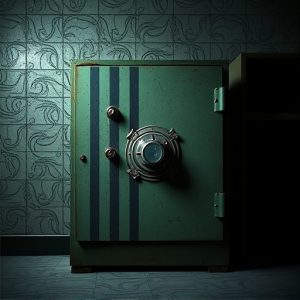Mastering Hidden Safes in Plain Sight: A Comprehensive Guide from Ancient Secrets to Modern Innovations
Hidden safes seamlessly integrate into everyday objects or architectural elements to secure valuable…….
Hidden safes seamlessly integrate into everyday objects or architectural elements to secure valuables while remaining undetected. These sophisticated security solutions are not only visually inconspicuous but also feature advanced locking systems ranging from traditional keys to cutting-edge electronic and biometric access controls. They are designed to be indistinguishable from their surroundings, whether that's a book on a shelf or an electrical outlet on a wall, and incorporate features like temperature control systems and sound-dampening materials for enhanced protection. The art of creating these safes dates back to ancient civilizations such as the Egyptians and Romans, who were adept at integrating secret compartments into their designs. Throughout history, the craft has evolved, culminating in modern hidden safes that continue to be 'in plain sight' within various settings, upholding a tradition of blending security with aesthetics. Today's hidden safes reflect a legacy where design and function converge, making them a discreet and effective means of protecting assets across generations.
Explore the intriguing world of covert storage solutions with our latest feature, “Secret Hiding Places.” This article unravels the mystery behind masterfully concealed safes and delves into their ingenious features. From the art of concealment to the legacy of past masters, we’ll reveal how hidden safes in plain sight have evolved throughout history. Join us as we explore the craftsmanship and mechanisms that make secret safes both functional and undetectable. Whether for security or discretion, understanding these elements can offer a new perspective on the preservation of valuables.
Unveiling the Art of Concealment: Mastering the Placement and Disguise of Hidden Safes
Mastery of hidden safes lies not merely in their secure construction but also in their strategic placement and effective disguise. A well-placed safe can protect valuables from both physical and digital threats, ensuring peace of mind for its owner. Hidden safes in plain sight often employ clever design and function as a decoy to the untrained eye, blending seamlessly with everyday objects or architectural features. For instance, a false-fronted book on a shelf or an inconspicuous wall outlet might conceal more than meets the eye. The art of concealment is a delicate balance between functionality and aesthetics; safes must not only be secure but also appear to serve their intended alternate purpose to avoid detection. Advanced models incorporate sophisticated locking mechanisms, temperature control systems, and even sound-dampening materials to safeguard against various risks. The placement of these safes requires a deep understanding of the environment they are in—be it a residential or commercial space—and an awareness of potential vulnerabilities that could compromise their security. By integrating hidden safes into environments in such a way, one ensures not only the protection of their assets but also maintains the integrity of their living or workspaces without raising suspicion.
The Anatomy of Ingenuity: Exploring the Features and Mechanisms of Secret Safes
The quest for securely storing valuables often leads individuals to consider hidden safes, cleverly designed to remain inconspicuous yet robust enough to protect their contents. These secret safes, often referred to as ‘hidden safes in plain sight,’ are masterpieces of ingenuity that blend seamlessly into everyday objects or architectural features. They are the epitome of stealth, with mechanisms ranging from falsely advertised antique boxes to intricately crafted wall fixtures that only reveal their true purpose upon careful inspection. The anatomy of these hidden safes is a marvel of design and functionality, incorporating hinges, locks, and sometimes even false walls or compartments, all designed to deceive the uninitiated while securely housing sensitive items.
Craftsmanship and innovation are at the heart of secret safes. These clandestine containers often feature sophisticated locking systems, ranging from traditional key-based mechanisms to high-tech electronic combinations, biometric access, or even remote control operations. The design of these hidden safes in plain sight is not only about security but also about creating a convincing facade that can fool even the most meticulous observer. The result is a harmonious blend of form and function, where the safe’s true purpose remains undetected until its owner desires to reveal it. This balance between utility and appearance makes secret safes an intriguing blend of art and security, ensuring that one’s valuables are not only safe but also hidden from prying eyes.
Historical Vignettes: A Look at Past Masters of Hidden Storage and Their Legacy Today
Throughout history, the quest for secure storage has led to the development of ingenious hidden safes that blended seamlessly with their surroundings. Ancient civilizations, from the Egyptians to the Romans, crafted concealed compartments within architectural elements, safeguarding valuables from would-be thieves and the passage of time. These early masters of hidden storage demonstrated a keen understanding of camouflage and design, integrating secret compartments into everyday objects and structures.
In the Renaissance period, artisans and inventors further refined the craft of concealment, creating intricate mechanisms and false fronts that were all but imperceptible to the untrained eye. The legacy of these past masters is evident today in the form of modern hidden safes, which continue to be designed and positioned ‘in plain sight,’ often as decorative or functional elements within homes, businesses, and institutions. Their influence can be seen in everything from antique furniture with secret drawers to contemporary security systems that blend technology with aesthetic appeal. The techniques and principles they established have evolved with the times, yet the essence of their craft—the art of hiding safes so effectively that they remain undetected until needed—remains as relevant as ever.


